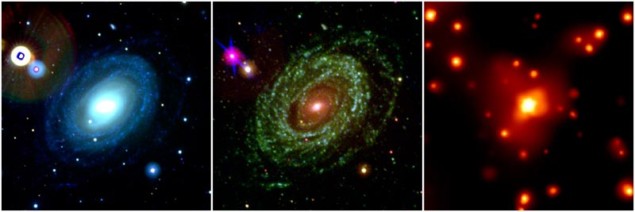
An international team of researchers has measured the mass of a distant exploding star system – and found that it weighs considerably more than the accepted mass limit for such bodies. As these type 1a supernovae are widely used as “standard candles” to measure distances in the universe, the finding could have important consequences in cosmology, particularly concerning theories of dark energy.
Type 1a supernovae occur when a white dwarf – thought to represent the end point of a star’s evolution – begins to gain mass by the accreting matter from a neighbouring star. Once the white dwarf reaches a critical mass of 1.4 solar masses, it will undergo a supernova explosion, which will always have the same brightness.
This stellar phenomenon proves very useful for astrophysicists because measuring the apparent brightness of a type 1a supernova infers its distance from our solar system, and measuring how this brightness changes over time can reveal the rate of expansion of the universe. Indeed, cosmologists have used this data to predict the existence of dark energy, which seems to be causing the expansion of the universe to accelerate.
Overweight candle
However, this study, led by Richard Scalzo of Yale University, reports that the white dwarf linked with SN 2007if, an established type 1a supernova, has a mass of 2.1 ± 0.2 solar masses, taking it far beyond the Chandrasekhar limit. The researchers arrive at this result after carefully examining the dimming of SN 2007if, which is occurring at a slower rate than would be expected for a supernova of this type.
The rate of dimming is determined by the efficiency of reactions taking place inside supernovae. Carbon and oxygen – the main constituents – are converted into radioactive nickel and then optical light. If there is more mass then the radioactive energy will be processed more efficiently and you’ll see a brighter supernova. “By watching the supernova fade away we can measure that efficiency and use it to estimate the mass,” Scalzo explained.
To make this discovery Scalzo and colleagues used ground-based telescopes in Chile, Hawaii and California to analyse the remnant of SN 2007if.
Having searched for several alternatives to explain this stellar heavyweight, Scalzo believes the likely candidate to be multiple white dwarfs, rather than a white dwarf and a neighbouring star. “If you have two white dwarfs they can slowly spiral inwards and eventually merge. When they merge they can potentially form something that is larger than the Chandrasekhar limit,” he said. However, the type of astrophysical objects that spawned this system remains unclear.
An opportunity, not a problem
Scalzo believes his findings might have opened the door to discovering more about this problem. “The question is whether there are other kinds of supernova that have similar physics but maybe are not as extreme. This might be telling us something about supernovae physics that we really need in order to standardize supernovae in future,” he tells physicsworld.com.
Even though Scalzo’s result indicates that not all type 1a supernovae are as neat and tidy as previously thought, dark energy is probably still safe, because there is still further evidence that it exists. “There is other observational evidence from the cosmic microwave background and galaxy surveys. Take any one of these away and dark energy still exists,” says Malcolm Fairbairn, a particle astrophysicist at King’s College London, who was not involved in the research. “However, it has been very worrying that we rely on type 1a supernovae as standard candles but we don’t really know exactly what they are,” he adds.
Scalzo agrees that a more detailed understanding of standard candles will be integral to the future of dark energy cosmology. “The implications are that the next generation of experiments require much greater precision than the generation that established the existence of dark energy. Then you might be able to say something about dark energy’s evolution with the expansion of the universe,” he said.
The findings have been accepted for publication in Astrophysical Journal.



